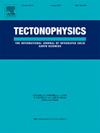从新的 cGPS 测量结果看喜马拉雅西北部喜马偕尔地区的异质性季节变形和应变预算:水文和地震灾害的影响
IF 2.7
3区 地球科学
Q2 GEOCHEMISTRY & GEOPHYSICS
引用次数: 0
摘要
我们分析了喜马拉雅西北部喜马偕尔邦新安装的 10 个永久性站点的 GPS 测量数据,主要目的是解读季节性地壳变形特征、其起源和水文影响。此外,我们还重点研究了全球定位系统站点的季节瞬变和长期静态运动对地震灾害的影响。我们的研究结果表明,全球水文载荷模型可以较好地解释印度-甘肃平原(IGP)季风降雨造成的地表时空位移,但对高喜马拉雅地区的冬季降雪解释不清。全球定位系统站点近似椭圆形的水平季节性运动似乎是由印度洋-甘地平原季风水文负荷的时空变化控制的。从 GPS 数据得出的水文过程表明,喜马偕尔喜马拉雅山的蓄水量在缓慢而稳定地恢复。更耐人寻味的现象是,在 COVID-19 锁定阶段的时间段内,储水量出现异常高的季节性站点抬升和长达一年(2020 年中至 2021 年中)的骤降,这可以推测为其对地壳变形历史的间接影响。季节应变分析显示了显著的空间异质性。GPS站点间不同的季节运动所产生的弧正向和弧平行季节应变似乎主要集中在锁定过渡带附近,而锁定段在很大程度上被平移,没有出现明显的应变。局部季节应变与背景地震率呈正相关,表明地震成核过程可能受到调制。区域地震灾害评估表明,未来可能发生 ∼Mw8.4 级大地震。另外观测到的最新应变预算(∼9.3 米)与之前报告的上一次大地震(约公元 1400-1500 年)期间的共震位移(∼9.3 米)之间的等效性,表明喜马拉雅山脉大地震的重现间隔为 600 年,具有很高的可靠性。本文章由计算机程序翻译,如有差异,请以英文原文为准。
Heterogeneous Seasonal Deformation and Strain Budget in Himachal, NW Himalaya from new cGPS measurements: Hydrological and Seismic Hazard Implications
GPS measurements from 10 new permanent sites installed in Himachal, NW Himalaya are analysed with the primary objective to decipher the seasonal crustal deformation characteristics, its origins and hydrological implications. Additionally, we focus on the seismic hazard implications of the seasonal transients as well as of the long-term secular motion of GPS sites. Our findings suggest that the global hydrological loading models can relatively well explain the temporal surface displacements resulting from the monsoon rainfall in the Indo-Gangetic plains (IGP) but poorly account for the winter snowfall in Higher Himalaya. The approximately elliptical horizontal seasonal motion of GPS sites seems to be controlled by the spatio-temporal variations in the monsoonal hydrological load over the IGP. The hydrological process derived from the GPS data suggests slow and steady recovery in the water storage in Himachal Himalaya. The more intriguing phenomena is reflected in the unusually high seasonal site uplift and the yearlong (mid-2020 – mid-2021) plunge in the water storage corresponding to the time-period of COVID-19 lockdown phases, which could be speculated as its indirect impact on the crustal deformation history. The seasonal strain analysis revealed significant spatial heterogeneity. The arc-normal and arc-parallel seasonal strain resulting from differential seasonal motion between GPS sites seems to be primarily localized in the vicinity of locking transition zone, while the locked segment is being largely translated without experiencing significant strain. The localized seasonal strain showed positive correlation with the background seismicity rate suggesting possible modulation of the earthquake nucleation process. The regional seismic hazard assessment suggests susceptibility to a future great earthquake of ∼Mw8.4. The additional observed equivalency between the updated strain budget (∼9.3 m) and the previously reported co-seismic displacement (∼9.3 m) during the last great earthquake around ∼1400–1500 CE, suggests a recurrence interval of ∼600 years for great earthquake events in Himachal Himalaya with significant reliability.
求助全文
通过发布文献求助,成功后即可免费获取论文全文。
去求助
来源期刊

Tectonophysics
地学-地球化学与地球物理
CiteScore
4.90
自引率
6.90%
发文量
300
审稿时长
6 months
期刊介绍:
The prime focus of Tectonophysics will be high-impact original research and reviews in the fields of kinematics, structure, composition, and dynamics of the solid arth at all scales. Tectonophysics particularly encourages submission of papers based on the integration of a multitude of geophysical, geological, geochemical, geodynamic, and geotectonic methods
 求助内容:
求助内容: 应助结果提醒方式:
应助结果提醒方式:


